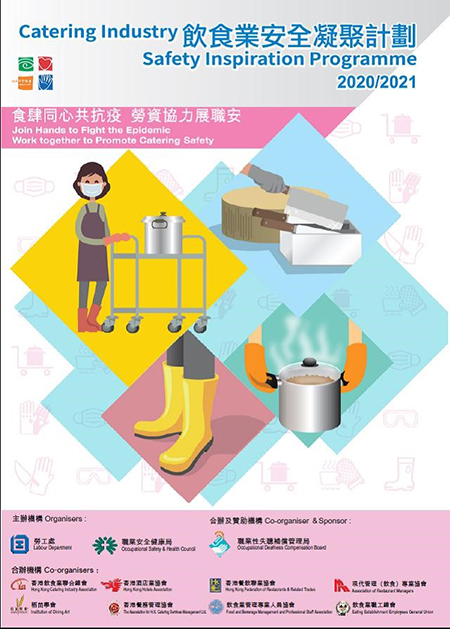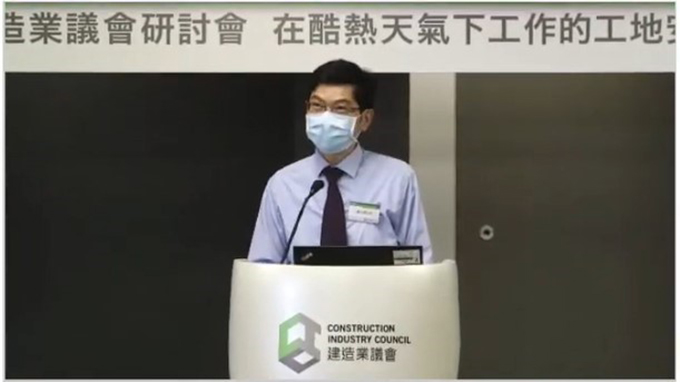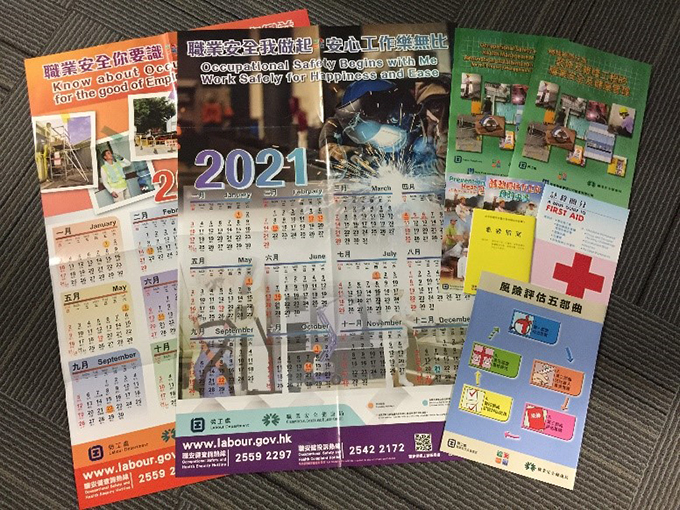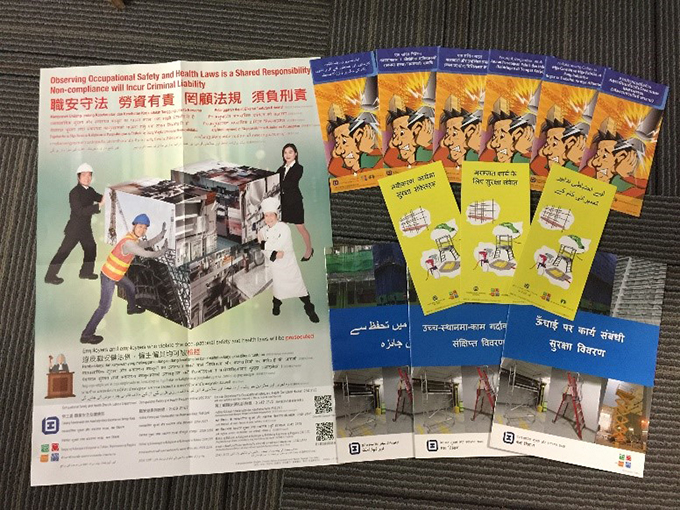Chapter 4 Safety and Health at Work
The Programme of Safety and Health at Work
www.labour.gov.hk/eng/osh/content.htm
4.1The Occupational Safety and Health Branch is responsible for the promotion and regulation of safety and health at work. The objective of the Programme of Safety and Health at Work is to ensure that risks to people’s safety and health at work are properly managed and reduced to the minimum through the three-pronged strategy of inspection and enforcement, education and training, as well as publicity and promotion. More specifically, we achieve the objective by:
- providing a legislative framework to safeguard safety and health at work;
- enforcing compliance with the Occupational Safety and Health Ordinance (OSHO), the Factories and Industrial Undertakings Ordinance (FIUO), the Boilers and Pressure Vessels Ordinance (BPVO) and their subsidiary regulations through inspection of workplaces to ensure that the requirements are complied with;
- investigating accidents and occupational health problems at workplaces and giving advice to employers and employees on how to reduce existing workplace hazards;
- offering advice to owners in the design and layout of workplaces, and in the implementation of safety programmes in workplaces;
- providing to employers, employees and the general public appropriate information and advice to promote knowledge and understanding of occupational safety and health (OSH); and
- organising promotional programmes and training courses to enhance safety awareness of the workforce.
4.2The OSHO protects employees’ safety and health at work generally in all branches of economic activities. It is a piece of enabling legislation that empowers the Commissioner for Labour to make regulations prescribing standards for general working environment as well as specific safety and health aspects at work.
4.3The FIUO regulates safety and health at work in industrial undertakings, which include factories, construction sites, cargo and container handling areas, as well as catering establishments.
4.4The BPVO aims at regulating the standards and operation of boilers and pressure vessels, including steam boilers, steam receivers and air receivers.
Our Work and Achievements in 2020
Work Safety Performance
4.5Through the concerted efforts of all parties concerned, including employers, employees, contractors, safety practitioners, and the Government and public sector organisations, Hong Kong’s work safety performance has been improving.
4.6The number of occupational injuries in all workplaces in 2020 stood at 27 127, whereas the number in 2011 was 40 578. The injury rate per thousand employees was 9.3 in 2020, and the rate in 2011 was 14.6. The number of industrial accidents for all sectors was 7 202, and the number in 2011 was 13 658. The accident rate per thousand workers for all sectors was 12.4, and the rate in 2011 was 23.6.
4.7In 2020, there were 2 532 industrial accidents in the construction industry, and the number in 2011 was 3 112. The accident rate per thousand workers in 2020 was 26.1, and the rate in 2011 was 49.7.
Occupational Diseases
4.8In 2020, there were 216 cases of confirmed occupational diseases, among which occupational deafness, silicosis and tenosynovitis of the hand or forearm were the most common.
4.9For more statistics on the OSH, please visit the webpage: www.labour.gov.hk/eng/osh/content10.htm.
Key Indicators of Work
4.10Some key indicators of work of this programme area are shown in Figure 4.1.
Inspection and Enforcement
4.11To ensure safety and health at work, we inspect workplaces, monitor health hazards, investigate work accidents and occupational diseases, register and inspect boilers and pressure equipment and advise on measures to control hazards and prevent accidents.
4.12We conduct promotional visits to give advice to employers on the prevention of accidents and encourage them to proactively adopt a self-regulatory approach in managing risks at the workplace. We also conduct enforcement inspections to various workplaces to ensure that duty holders have observed relevant statutory requirements stipulated in safety legislation. We adopt a risk-based approach to adjust the intensity of inspection and enforcement efforts from time to time to effectively combat unsafe acts.
4.13In 2020, we continued to place workplaces with poor safety performance under close surveillance. Improvement notices or suspension notices were issued when necessary to secure speedy rectification of irregularities, or to remove imminent risks to lives. In 2020, we also conducted eight special enforcement operations targeting specific workplace hazards or workplaces with higher risk work processes, including new works; repair, maintenance, alteration and addition (RMAA) works; electrical works; bamboo scaffolding; sea-based construction works; waste management works as well as logistic, cargo and container-handling industries. In these eight operations, a total of 9 521 workplaces were inspected, with 991 improvement notices and 87 suspension notices issued to duty holders, and 574 prosecutions initiated. Besides, we launched 23 in-depth surprise inspections to work sites with higher risk processes or poor safety performance. A total of 457 suspension/improvement notices were issued and 209 prosecutions initiated. In order to enhance safety performance of public work projects, representatives of the Labour Department (LD) participated in 245 site safety management committee meetings of public work projects and provided safety advice, in particular that concerning work processes with relatively high risk, to the contractors and relevant duty holders.
4.14We conduct investigations into complaints concerning unsafe conditions or malpractices in workplaces. In 2020, we handled 293 complaints lodged by workers and initiated 17 prosecutions arising from investigation of these cases. Through the intelligence reporting system on unsafe RMAA works developed with various strategic partners, a total of 9 124 complaint/referral cases were received. As a result of the follow-up inspections on these referral cases, we issued 197 suspension/improvement notices and took out 100 prosecutions.
4.15The LD launched the online OSH complaint platform in 2019 to facilitate employees using mobile electronic devices such as smart phones, tablets or laptops to report unsafe working conditions so that the LD can conduct prompt follow-up actions. The LD also produced a set of TV and Radio Announcements in the Public Interest (API), and made use of various channels such as training courses organised by Mandatory Safety Training (MST) course providers and workers registration service centres, to promote the complaint platform widely. In 2020, the LD received a total of 1 154 OSH complaint cases through the platform. A total of 13 suspension notices and 91 improvement notices were issued and 44 prosecutions were/will be taken out by the LD upon discovery of breaches of OSH legislation from the above complaints.
4.16To enhance the OSH of construction workers through more targeted safety inspections, the LD collaborates with the property management sector to strengthen the referral mechanism for RMAA works to be carried out in individual units of estates, particularly the relatively high risk works such as erection or dismantling of truss-out scaffolds, so that the LD can conduct targeted safety inspections in a timely manner. The refined referral mechanism was launched in January 2020.
4.17In 2020, the LD continued to organise enforcement campaign and publicity targeting outdoor workplaces with a higher risk of heat stroke. These workplaces include construction sites, outdoor cleansing workplaces, horticulture workplaces and container yards. In the special enforcement campaign from April to September, we conducted a total of 21 961 surprise inspections, and issued two improvement notices and 11 warnings.
4.18Targeting health risks of standing at work, the LD in 2020 conducted inspections at workplaces of various industries including catering, retail and property management. In the year, the LD conducted 69 surprise inspections and issued 18 warnings.
4.19The Commissioner for Labour, as the Boilers and Pressure Vessels Authority, recognises competent inspection bodies to assess and inspect new pressure equipment during manufacturing. In addition, the LD conducts examinations, monitors courses for training of competent persons and issues certificates of competency to qualified candidates as competent persons for various types of boilers and steam receivers. In 2020, 351 applications for certificates of competency were processed, with 349 certificates issued/endorsed. We also advised the Fire Services Department on matters related to the approval and preliminary inspections of pressurised cylinders and storage installations for compressed gas.
4.20As at the end of 2020, the LD recorded a total of 226 081 workplaces, including 28 870 construction sites. In the year, 105 286 inspections were conducted under the OSHO, the FIUO and their subsidiary regulations. As a result, 20 261 warnings and 3 104 suspension or improvement notices were issued. Besides, 3 795 inspections were made under the BPVO. 3 043 warnings were given and 6 prohibition orders on the use and operation of boilers and pressure vessels were issued. We also carried out 13 529 and 1 866 investigations on work accidents and suspected occupational diseases/occupational health problems respectively in the year. We also conducted 3 832 occupational hygiene surveys on workplace health hazards.
Education and Training
4.21We provide training-related services to employers, employees and relevant parties to foster an OSH culture among the working population. They include provision of training courses, recognition of MST courses and registration of safety officers and safety auditors.
4.22In 2020, we organised 194 safety and health training courses related to relevant legislation for 1 184 employees and 115 tailor-made talks to individual industries or organisations for another 20 817 employers. We also recognised three mandatory basic safety training courses (commonly known as “green card” courses) for construction and container-handling work, two MST courses for confined spaces operation, two MST courses for operators of loadshifting machine and one MST course for persons working on suspended working platforms. We also continued to refine the MST courses, and launched the revamped Safety Training Courses of Gas Welding and Safety Training Courses for Persons Working on Suspended Working Platforms to further strengthen workers’ knowledge of the associated risks and emergency preparedness to avoid accidents. We have a system in place to monitor these MST courses. We conducted different modes of monitoring inspections, including surprise inspections and covert inspections which involved inspecting officers in the guise of a course participant, to ensure that the courses were delivered in accordance with the course contents.
4.23In 2020, we registered 156 persons as safety officers and 49 as safety auditors. As at the end of the year, there were 3 977 safety officers with valid registration and 1 430 registered safety auditors. Furthermore, a total of 516 applications for renewal or revalidation of registration as safety officers were approved in 2020.
4.24Occupational health education raises employers’ and employees’ awareness of the prevention of occupational health hazards and occupational diseases. In 2020, we organised a total of 365 health talks on various occupational health issues for over 25 100 participants. Apart from open health talks, we also conducted outreaching health talks at the workplaces of individual organisations. These health talks covered various occupations with more than 40 different topics such as Occupational Health for Office Workers, Manual Handling Operations and Prevention of Back Injuries, Occupational Health for Cleansing Workers, Prevention of Lower Limb Disorders and Occupational Health in Catering Industry. Owing to the COVID-19 pandemic in 2020, some of the health talks were conducted online so that employers and employees could continue to participate in them.
4.25The LD uploaded Work Safety Alerts and Systemic Safety Alerts on the LD’s website respectively to help raise the safety awareness of employers, contractors and workers and to remind the Registered Safety Officers and Registered Safety Auditors in exercising their statutory functions to advise their employers/clients to fulfill their safety responsibilities and render the necessary assistance. Work Safety Alerts summarised recent fatal and serious work accidents, and highlighted general safety precautionary measures whereas Systemic Safety Alerts provided accident prevention measures arising from the major systemic problems. In 2020, we continued to produce Work Safety Alerts in the form of animation videos to enable the industry to better comprehend how accidents happened and the necessary precautionary measures to be taken for preventing recurrence of similar accidents. Five animation videos on various topics, including work-at-height safety and electrical work safety, were uploaded to the LD’s website and widely disseminated through different channels.
Publicity and Promotion
4.26We held a series of promotional campaigns in 2020 to heighten safety awareness among employers and employees and to cultivate a positive safety culture at the workplaces, with some jointly organised with relevant stakeholders such as the Occupational Safety and Health Council (OSHC), trade associations, workers’ unions and other government departments.
4.27In view of the COVID-19 pandemic, we suspended the “Catering Industry Safety Award Scheme” and the “Construction Industry Safety Award Scheme” in the year. In order to continue to urge the industries to take practical safety measures and improve working environment to reduce accident risks, we launched the new “Catering Industry Safety Promotional Campaign” and “Construction Industry Safety Promotional Campaign” in 2020. The “Catering Industry Safety Promotional Campaign” included organising the “Catering Industry Safety Inspiration Programme” and producing catering safety animation videos. Employers and employees participating in the programme were required to make commitments on OSH enhancement. For the animation videos, they were uploaded to the LD’s website and widely broadcast through various channels to promote catering safety. The “Construction Industry Safety Promotional Campaign” consisted of two major parts, namely a “Construction Industry Safety Short Film Competition” and a series of safety publicity activities such as the display of large billboards at the cross harbour tunnels and MTR buildings.

Construction Industry Safety Promotional Campaign – Construction Industry Safety Short Film Competition
4.28Accidents in RMAA works have become a source of concern in recent years. In 2020, the LD, in collaboration with the OSHC, launched a two-year publicity campaign to remind contractors and workers to pay special attention to safety while carrying out RMAA works, and the related electrical work, and working at height. Two safety webinars on safety management for high risk operation safety and truss-out bamboo scaffolding work safety were held in August and September 2020 respectively. Other major publicity activities included broadcasting APIs on television/radio/mobile media, staging roving exhibitions, publishing feature articles in newspapers and on the LD’s website, publishing leaflets and disseminating safety messages to contractors, employers and employees through various means.
4.29We also collaborated with relevant organisations, including the OSHC, the Pneumoconiosis Compensation Fund Board, the Occupational Deafness Compensation Board, employers’ associations, trade unions and community groups in promoting occupational health through a variety of activities such as organising occupational health award, holding health talks, distributing promotional materials. Moreover, we promoted the prevention of common work-related diseases, such as musculoskeletal disorders which are common among service and clerical personnel and manual workers. Since 2018, we have been collaborating with the Department of Health and the OSHC to jointly organise the “Joyful@Healthy Workplace” programme to promote physical and mental health among employers and employees at workplaces. In July 2020, we further collaborated with the Department of Health and the OSHC to roll out the “Mental Health Workplace Charter” with a view to promoting a mental health-friendly workplace environment.
4.30The LD also stepped up publicity on the prevention of heat stroke at work through a multitude of activities such as organising public and outreaching health talks, distributing publications and promotional posters, showing educational videos and displaying advertisements on mobile advertising media, and issuing press releases. From May to September 2020, we continued to collaborate with the OSHC in launching a large-scale promotion campaign on heat stroke prevention. Through distributing protective equipment (e.g. cooling towels, arm covers, water bottles and newly added portable waist fans), broadcasting a publicity video and conducting extensive publicity, the campaign reminded employers and employees to prevent heat stroke at work. The main targets of the campaign included construction workers, outdoor cleansing workers, horticulture workers, security guards, container terminal workers, airport apron workers and recycling workers.
4.31With effect from April 2020 and as proposed by the LD, the Hong Kong Observatory has added an alert on heat stroke prevention when issuing push messages of Very Hot Weather Warning to the public through mobile apps, to provide timely alert to employees and the public.
4.32To better assist large corporations in enhancing their occupational health performance, the Occupational Health Service of the LD set up a Central Promotion Team in August 2020. The team aimed to promote good work practice to the management of these corporations to ensure the occupational health of employees. The team set out the theme for promotion with regard to the work situation and occupational health risks of specific industries. The team visits targeted large corporations to explain to them the relevant requirements under the legislation and guidelines relating to the theme and urge them to implement relevant measures through a top-down, holistic and unified approach for strengthening the protection of workers’ health at work. Up to the end of 2020 after its set-up, the Central Promotion Team conducted promotional visits to a total of 36 large corporations of the targeted industries including the retail industry, catering industry and property management industry. Advice was given to the employers to follow the requirements of the “Guidance Notes on Standing at Work and Service Counter Design” issued by the LD to further reduce health risks associated with standing at work. In addition, the team also conducted promotional visits to all the five street cleaning contractors of the Food and Environmental Hygiene Department and advised them to adopt precautionary measures to prevent heat stroke of cleaning workers during work.
4.33In 2020, the LD published five new/revised OSH publications and one DVD, including “Five Steps to Risk Assessment” and “Occupational Safety and Health Management in Renovation and Maintenance Works for the Property Management Industry” for promoting work safety and health. Besides, we published 13 OSH publications in six languages of diverse race (Indonesian, Hindi, Nepali, Tagalog, Thai and Urdu), such as “A Pictorial Guide to Factories and Industrial Undertakings (Noise at Work) Regulation”, “Safety Hints on Renovation Work”, “Overview of Work at Height Safety” and “Observing Occupational Safety and Health Laws is a Shared Responsibility” poster, with a view to enhancing the safety awareness of workers of diverse race.
4.34In 2020, the Occupational Safety and Health Branch handled 10 903 enquiries, advising on various safety and health matters. Furthermore, the Occupational Safety and Health Centre provides information and advisory services to employers and workers.
4.35The LD collaborated with the property management sector to promote RMAA work safety and to step up the promotion of work-at-height safety to stakeholders, including contractors and workers, on the use of suitable working platforms instead of ladders for working above ground and the use of safety helmets with chin straps. We collaborated with the OSHC to consolidate the “Pilot Partnership Scheme on Promotion of Light-duty Working Platforms by Property Management Companies” by simplifying the lending procedures and expanding the coverage of the scheme to include contractors and workers conducting RMAA works in relevant estates or residential buildings.
4.36Using straight ladders or A-ladders for work-at-height carries a lot of risk. In the past, there were several fatal accidents which involved workers falling from these ladders. In order to enhance the safety awareness of employers and workers in work-at-height, the LD collaborated with the OSHC to continue with the Enhanced Light-duty Working Platform Sponsorship Scheme for SMEs by subsidising small and medium enterprises (SMEs) to purchase enhanced step platforms and hop-up platforms for above-ground work. As at December 2020, 676 applications were received with 598 approved, benefiting over 10 200 workers.
4.37The LD collaborated with the OSHC to ride on the Home Affairs Department’s community platforms to promote the RMAA works safety particularly work-at-height safety, to owners’ corporations, property owners and tenants, etc.
4.38To promote safety awareness of the industry in operating boilers and pressure vessels, we distributed around 1 800 publications and leaflets regarding registration and safe operation of pressure equipment.
Clinical Occupational Health Services
4.39The LD runs occupational health clinics in Kwun Tong and Fanling, providing clinical consultations, medical treatment as well as occupational health education and counselling services for workers suffering from work-related and occupational diseases. Workplaces of the patients are inspected if necessary to identify and evaluate occupational health hazards in the work environment.
4.40In 2020, 6 327 clinical consultations were rendered. Moreover, patient support groups were organised to help patients achieve more desirable rehabilitation progress through health talks, experience sharing and peer support.



